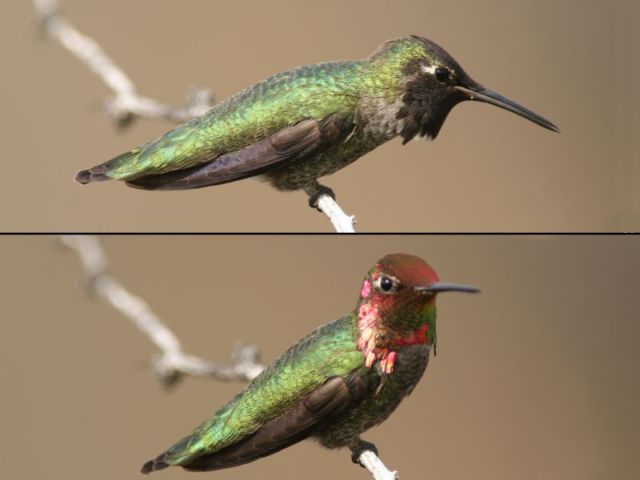Hummingbirds even at rest have a metabolic rate more than fifty times as fast as a man’s. Its resting heartbeat is 480 beats per minute and can go as high as 1,260 per minute when excited. Resting hummingbirds breathe 250 times a minute and feed about every 15-20 minutes all day long, more at dawn and dusk, to maintain their energy levels. After filling their crop by sipping nectar hummingbirds will rest while the crop is emptying into the rest of the digestive system and forage again when the crop is about half-empty.
When the weather is bad and they can't feed they will go into a state of torpor to save energy. The hummingbirds are still and stiff and cannot fly. Incubating and brooding females don't go into torpor; otherwise, eggs and un-feathered nestlings would perish. This swing from hyper-activity to torpor and the gorging on food, reminds me so much of my sons in their teenage years.
If ordinary birds are sailplanes with feathered propellers at their wingtips, then hummingbirds are helicopters, a machine the Duchess Massena could only have conceived had she studied Leonardo Da Vinci’s mechanical drawings. These remarkable living helicopters can fly straight up, hover, fly backwards, and even, for short distances, upside down. Their wings are structurally different from those of other birds; they are almost rigid, moving little at the wrist and elbow, but rotating freely at the shoulder joint. During hovering, the wings describe a figure eight from 22 to 72 times per second, as if the tiny bird were sculling through the air. Like a helicopter, it cannot walk, but must use its wings just to change position on a twig.
The breast muscles of Anna’s Hummingbird are estimated to be approximately four times as large, proportionately, as those of a pigeon. This great muscle burden is one price the bird pays for being small. The rapid wing motion causes them to expend most of their energy in flight; hummingbirds can consume half of their body weight in food per day.
We know that they visit flowers for nectar and in so doing brush pollen onto specific areas of their heads, for example, fuchsia’s deposit pollen on the bird’s throat. The next fuchsia visited receives the pollen and may get a few fuchsia mites into the bargain. Hummingbirds possess a long, slender tongue that extends far beyond the tip of the bill. The hyoid apparatus, a forked structure made of a number of small bones and connected muscles, wraps around the entire skull, coils around the eyes, and controls the tongue extension. (Woodpeckers have a similar arrangement). Hummingbirds’ tongues have long grooves, and the outer half is divided although the split is rarely visible. Capillary action, a physical force that causes fluids to rise in small diameter tubes, carries nectar up tiny grooves running the length of the tongue to the mouth, with no sucking required.
Hummingbirds will make daily rounds in which they will visit patches of flowers and feeders in a predictable sequence called trap lining. Their diet consists of far more than carbohydrates. Invertebrate prey includes fruit flies, gnats, mosquitoes, thrips, aphids, caterpillars, ants, insect eggs, and spiders and their eggs. These small arthropods help them meet protein, vitamin and mineral requirements. Hummers feed on insects by hawking like flycatchers, gleaning from leaf surfaces, and poaching from sapsucker holes. They also glean small insects trapped in spider webs. They eat spiders and gorge on eggs and young then pilfer their webbing to build their nests.

Back to ... Mendocino Coast Audubon Society Newsletter Articles | Home page